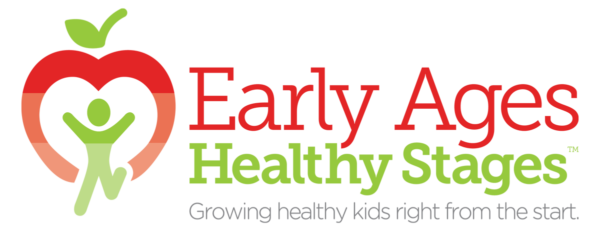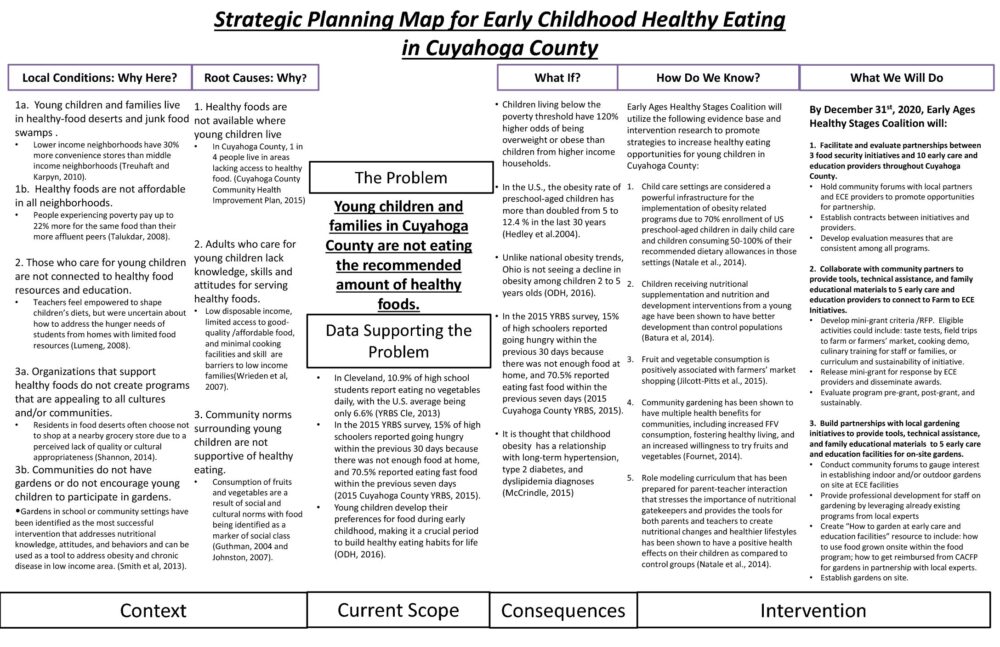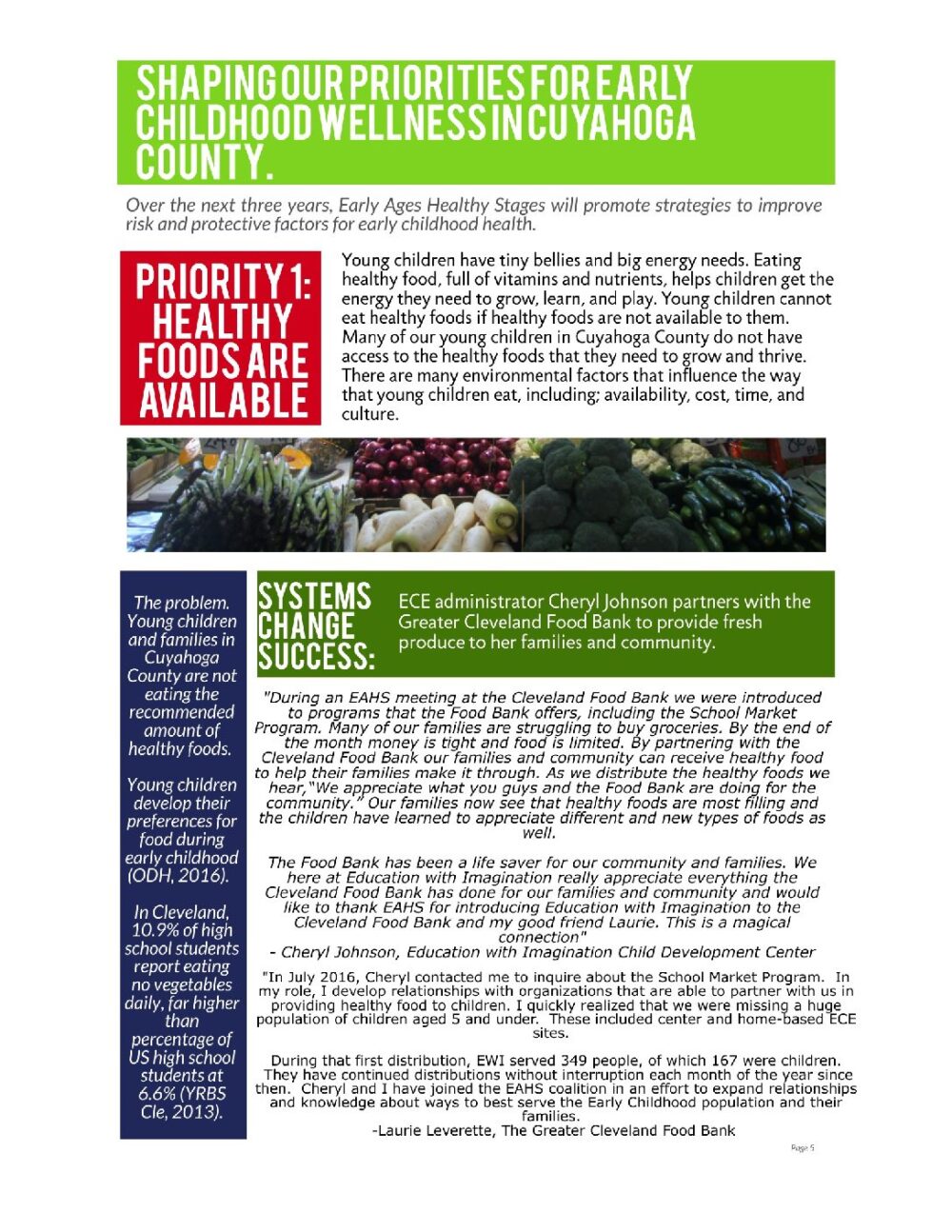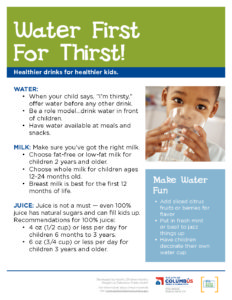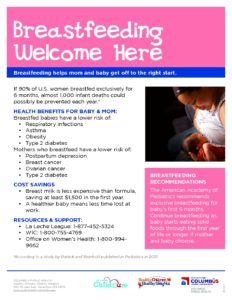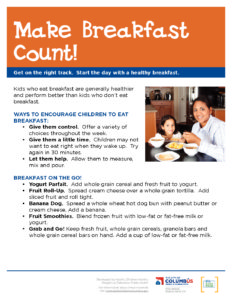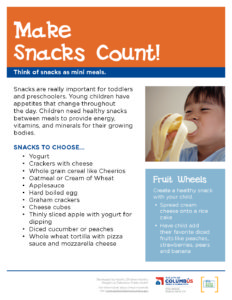Healthy Foods
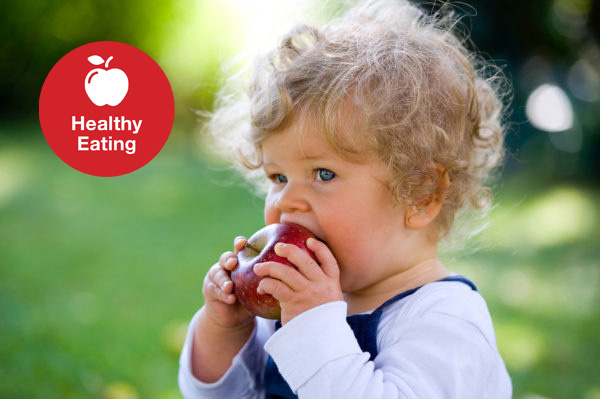
Young children have tiny bellies and big energy needs. Eating healthy food, full of vitamins and nutrients helps children get the energy they need to grow, learn, and play. Young children cannot eat healthy foods if healthy foods are not available to them. Many of our young children in Cuyahoga County do not have access to the healthy foods that they need to grow and thrive. There are many environmental factors that influence the way that young children eat, including availability, cost, adult food literacy, time, and culture.
Healthy Foods | Our Goal:
Early Ages Healthy Stages will collaborate with our partners to improve systems and leverage programs that make healthy eating both accessible and desirable in Cuyahoga County.
Healthy Foods | Strategies for Change: The table below outlines what we will do to achieve this goal.
The problem. Young children and families in Cuyahoga County are not eating the recommended amount of healthy foods. Young children develop their preferences for food during early childhood, making it a crucial period to build healthy eating habits for life (ODH, 2016). In Cleveland, 10.9% of high school students report eating no vegetables daily, far higher than percentage of US high school students at 6.6% (YRBS Cle, 2013).
Healthy Foods | Objective 1. Early Ages Healthy Stages Coalition will facilitate and evaluate partnerships between food security initiatives and early care and education providers throughout Cuyahoga County.
- Hold community forums with local partners and ECE providers to promote opportunities for food security partnerships.
- Establish contracts between food security initiatives and ECE and other direct service providers, if needed.
- Develop evaluation measures that are consistent among all programs and initiatives.
- Documentation of partnerships between ECE sites and healthy food organizations
- Measuring the number of lbs of foods served at ECE centers
- Measuring the number of families served by food security partnerships
- Shared success stories at Coalition meetings annually
Healthy Foods | Objective 2. Early Ages Healthy Stages Coalition will, collaborate with community partners to provide tools, technical assistance, and family educational materials to early care and education providers to connect them to Farm to ECE Initiatives.
- Engage community partners to gather resources for Farm to ECE Initiatives throughout Cuyahoga County related to Farm to ECE domains: procurement, education and experiential learning, and gardening.
- Modify and/or develop tool kits for connecting ECE providers to local foods initiatives as needed.
- Connect ECE and other direct service providers to Farm to ECE activities. Eligible activities could include: taste tests, field trips to farm or farmers’ market, cooking demos, culinary training for staff or families, or curriculum and sustainability of initiative.
- Secure funding for activities for broader dissemination of initiatives, if needed.
- Evaluate initiatives pre, post, and sustainably.
- Measuring the number of providers and organizations taking “Feed Out Future” Pledge
- Measuring the number of ECE centers and organizations at which information and educational materials are distributed
- Measuring the number of resulting contracts and partnerships formed between ECE centers and Farm to ECE initiatives
Healthy Foods | Objective 3. Early Ages Healthy Stages Coalition will build partnerships with local gardening initiatives to provide tools, technical assistance, and family educational materials to early care and education facilities for on-site gardens.
- Conduct community forums to gauge interest in establishing indoor and/or outdoor gardens on site at ECE facilities.
- Provide professional development for ECE staff and other interested partners on gardening by leveraging already existing programs from local experts.
- Create “How to garden at early care and education facilities” resource to include; how to use food grown onsite within the food program, how to get reimbursed from the USDA Child and Adult Care Food Program (CACFP) for gardens in partnership with local experts.
- Establish gardens on site at ECE facilities.
- Evaluate the impact of gardens on eating/activity habits of children and families, as well as the sustainability of the project.
- Measuring the number of new gardens established
- Measuring the number of children and families reached by gardens
- Measuring the number of ECE centers reached through initiatives
Healthy Foods Working Group:
Co-Facilitators: Liza Ickes & Lauren Moss
Healthy Foods Handouts:
Key Massages Handouts:
Sources:
2015 Cuyahoga County Youth Risk Behavior Survey (2015). Prevention Research Center for Healthy Neighborhoods. Acessed June 12, 2017 from http://filecabinet.eschoolview.com/C40D9087-4DD3-4B32-B127-09EE6162B0E7/YRBS%20Data/Overall%20Prevalence%20County.pdf
Batura, N., Hill, Z., Haghparast-Bidgoli, H., Lingam, R., Colbourn, T., Kim, S., . . . Skordis-Worrall, J. (2015). Highlighting the evidence gap: how cost-effective are interventions to improve early childhood nutrition and development?. Health Policy and Planning, 30(6), 813-821. doi:10.1093/HEAPOL/CZU055
Cardiovascular Disease Prevention and Control: Interventions Engaging Community Health Workers (2015). Community Preventative Services Task Force. Retrieved from: https://www.thecommunityguide.org/sites/default/files/assets/CVD-Community-Health-Workers.pdf
Cuyahoga County Community Health Improvement Plan. Health Improvement Partnership – Cuyahoga. 2015. Available at: http://hipcuyahoga.org/wp-content/uploads/2016/02/HIPC_CHIP_Web-1.pdf
De Onis, M., Blo¨ssner, M., & Borghi, E. (2010). Global prevalence and trends of overweight and obesity among preschool children. American Journal of Clinical Nutrition, 92(5), 1257–1264.
Fournet, R. (2014). Teaching Gardening and Food Choices to Children Living in a Food Desert. Journal of the Academy of Nutrition and Dietetics, 114(9), A88. doi:10.1016/J.JAND.2014.06.297
Guthman J, Morris A, Allen P (2006) Squaring farm security and food security in two types of alternative food institutions. Rural Sociology 71: 662–684
Hedley, A. A., Ogden, C. L., Johnson, C. L., Carroll, M. D., Curtin, L. R., & Flegal, K. M. (2004). Prevalence of overweight and obesity among US children, adolescents, and adults, 1999–2002. Journal of the American Medical Association, 291(23), 2847–2850.
Jilcott-Pitts SB, Wu Q, Demarest CL, et al. Farmers’ market shopping and dietary behaviours among supplemental nutrition assistance program participants. Public Health Nutr 2015; 18: 2407–2414.
Johnston J (2007) Counter-hegemony or bourgeois piggery? Food politics and the case of foodshare. In: Wright W,Middendorf G (eds) The fight over food: Producers, consumers, and activists challenge the global food system. Pennsylvania State University Press, State College, PA.
Kato, Y. and McKinney, L. (2015), “Bringing food desert residents to an alternative food market”, Agriculture and Human Values, Vol. 32 No. 2, pp. 215-227.
Kelsey, M. M., Zaepfel, A., Bjornstad, P., & Nadeau, K. J. (2014). Age-related consequences of childhood obesity. Gerontology, 60(3), 222-8. doi:http://dx.doi.org/10.1159/000356023
Lumeng JC, Kaplan-Sanoff M, Shuman S, Kannan S. Head Start teachers’ perceptions of children’s eating behavior and weight status in the context of food scarcity. J Nutr Educ Behav 2008;40:237–243.
McCrindle, Brian W (2015). Cardiovascular Consequences of Childhood Obesity, Canadian Journal of Cardiology, Volume 31, Issue 2, 2015, Pages 124-130, ISSN 0828-282X, http://dx.doi.org/10.1016/j.cjca.2014.08.017.
Monsivais, P., & Drewnowski, A. (2007). The rising cost of low-energy-density foods. Journal of the American Dietetic Association,107(12), 2071–2076.
Natale, R. A., Messiah, S. E., Asfour, L., Uhlhorn, S. B., Delamater, A., & Arheart, K. L. (2014). Role Modeling as an Early Childhood Obesity Prevention Strategy. Journal of Developmental & Behavioral Pediatrics, 35(6), 378-387. doi:10.1097/dbp.0000000000000074
Physical Activity: Family-Based Interventions (2017). Community Preventative Services Task Force. Retrieved from https://www.thecommunityguide.org/sites/default/files/assets/OnePager-Physical-Activity-family-based.pdf
Sheerin, F., Stonebanks, C. D., Jeffery, K., & Schouten, K. (2016). Health and wellness in rural malawi: A health development initiative. Primary Health Care (2014+), 26(9), 34. doi:http://dx.doi.org/10.7748/phc.2016.e1158
Singh, G. K., Siahpush, M., & Kogan, M. D. (2010a). Rising social inequalities in US childhood obesity, 2003–2007. Annals of Epidemiology, 20(1), 40–52.
Smith, D., Miles-Richardson, S., Dill, L., & Archie-Booker, E. (2013). Interventions to improve access to fresh food in vulnerable communities: A review of the literature. International Journal on Disability and Human Development, 12(4), 409-417. doi:http://dx.doi.org/10.1515/ijdhd-2013-0203
Talukdar, D. (2008). Cost of being poor: Retail price and consumer price search differences across inner-city and suburban neighborhoods. Journal of Consumer Research, 35(3), 457–471.
Treuhaft, S., & Karpyn, A. (2010). The grocery gap: Who has access to healthy food and why it matters. Oakland and Philadelphia: Policy Link. Talukdar, D. (2008).
Profile of SNAP Households, Ohio Congressional District 11 (2017). U.S. Department of Agriculture, Food and Nutrition Service. Retrieved from https://fns-prod.azureedge.net/sites/default/files/ops/Ohio_11.pdf
Profile of SNAP Households, Ohio Congressional District 9 (2017). U.S. Department of Agriculture, Food and Nutrition Service. Retrieved from https://fns-prod.azureedge.net/sites/default/files/ops/Ohio_9.pdf
U.S. Department of Health and Human Services (2011). Benefit redemption patterns in the supplemental nutrition assistance program. Food and Nutrition Service. Accessed June 9, 2017 from http://www.fns.usda.gov/sites/default/files/ARRASpendingPatterns_Summary.pdf
Wrieden, W., Anderson, A., Longbottom, P., Valentine, K., Stead, M., Caraher, M., . . . Dowler, E. (2007). The impact of a community-based food skills intervention on cooking confidence, food preparation methods and dietary choices – an exploratory trial. Public Health Nutrition, 10(2), 203-211. doi:10.1017/S1368980007246658
